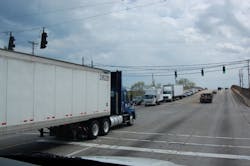Now get ready for this unpleasant twist in the story. Earlier this month, after a week-long meeting back in June, the International Agency for Research on Cancer (IARC) – part of the World Health Organization (WHO) – definitively classified diesel engine exhaust and “fumes” as carcinogenic to humans (or "Group 1") based on what they call “sufficient evidence” that exposure is associated with an increased risk for lung cancer, as well as bladder cancer.
Here’s the best part – diesel fumes now fall into the same risk category as tobacco, mustard gas, sunlight (gee, better tell the sun to turn the ultraviolet radition down ...), Chinese salted fish, vinyl chloride, soot and wood dust, among other substances, according to IARC.
OK … MUSTARD GAS?? REALLY?? Last I checked this chemical agent packed a hell of vicious punch nowhere NEAR that of “diesel fumes.” As one of the most infamous and feared weapons devised for the World War I battlefield, mustard gas inflicted severe skin ulcerations, blindness, and respiratory burns on its victims.The evil Iraqi dictator Saddam Hussein (thankfully now several years in the grave) killed between 3,200 and 5,000 Kurdish men, women and children in the town of Halabja back in 1988 – while sickening some 10,000 more – in one of the last known uses of mustard gas as a weapon.
And now DIESEL is being placed in the same league as this horrific chemical???
[There’s also the curious – and wholly frightening – addition of “Chinese salted fish” to this dastardly list. Best avoid THAT if you find it on a menu.]
Now, this link between diesel fumes and cancer is not a new one. Indeed, IRAC classified diesel fumes back in 1988 as “Group 2A” compounds – considered "probably" carcinogenic to humans.
Now, however, this “Group 1” classification takes things to a whole new level. Oh but wait – what about all that expensive emission control technology that’s been mandated for trucks over the past decade in Europe and the U.S.? Doesn’t that alleviate the problem?
Not necessarily, according to IARC’s position. “Increasing environmental concerns over the past two decades have resulted in regulatory action in North America, Europe and elsewhere with successively tighter emission standards for both diesel and gasoline engines,” the group said.“However, while the amount of particulates and chemicals are reduced with these [technological] changes, it is not yet clear what the quantitative and qualitative changes may translate into,” IARC noted. “In addition, existing fuels and vehicles without these modifications will take many years to be replaced, particularly in less developed countries, where regulatory measures are currently also less stringent. It is notable that many parts of the developing world lack regulatory standards, and data on the occurrence and impact of diesel exhaust are limited.”
“The scientific evidence was compelling and the conclusion was unanimous: diesel engine exhaust causes lung cancer in humans,” said Dr. Christopher Portier, chairman of the IARC’s working group on diesel exhaust. “Given the additional health impacts from diesel particulates, exposure to this mixture of chemicals should be reduced worldwide.“
Dr. Christopher Wild, director of the IARC, added an even more sobering thought for truckers to contemplate.“While IARC’s remit is to establish the evidence-base for regulatory decisions at national and international level, today’s conclusion sends a strong signal that public health action is warranted,” he stressed. “This emphasis is needed globally, including among the more vulnerable populations in developing countries where new technology and protective measures may otherwise take many years to be adopted."
So here we sit, with untold millions spent over the last decade and a half developing diesel exhaust emission reduction technology – with the sticker prices of new Class 8 trucks some $22,000 to $25,000 higher as a result – and the conclusion of one of the world’s leading health groups is that it "might not be good enough." That MORE technology may need to be deployed and money may need to be spent on eliminating diesel exhaust emissions (what little are left of them, I might add, after the 2010 round of mandates).
Of course, there’s no suggestion as to what replaces diesel, of course. That of course isn’t a problem doctors can solve. Maybe they should, though: that would perhaps open their eyes to the role diesel plays across the world in supporting everything that makes modern life possible.




